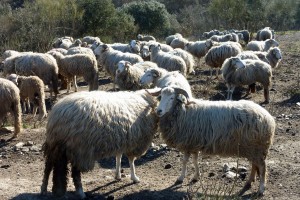As I stood in the crisp air and bright sun of a Portuguese farm with the other Slow Food University of Gastronomic Sciences students, a single question popped into my mind. We were learning about the Churra da Terra Quente sheep breed, an indigenous and endangered animal with tangled wool and long, dirty tails. They were a rough-looking lot, but watched us curiously and weren’t as shy as other sheep I’ve unwittingly terrified just by standing by them. Some scratched their dirty wool on dry tree trunks, and others flopped down onto the dry soil that was bereft of rain for 4 ½ months, unconsciously dirtying themselves even more. They had curly horns like trofiette pasta. I got the impression that they were happy, or content, to be out in the sun watching us watching them.

Churra da Terra Quente sheep in the dry Douro
In an indigenous flock – or group, or pack, or what-have-you – the purity of the breed is kept by inbreeding. In dogs, I know this leads to some odd character traits: Dalmations, for example, can be suddenly temperamental; my family’s Vizsla at times suffered anxiety and, strangely for a dog, psychological problems – and was also, of course, the most intelligent dog on earth.
Gazing into the white faces of these sheep, their heads tilted to the side and following us curiously, I couldn’t help but wonder: what has inbreeding done to their intelligence and personality? Are they smarter, or dumber? Do they have more personality, weird ticks, or anything different than the common fluffy white sheep (my knowledge of sheep breeds is rather limited)? Why are they staring at us like that?
The Churra da Terra Quente sheep are raised by Portuguese farmers in the Douro province. They are considered indigenous (although technically, if your definition of “indigenous” goes back far enough, all sheep come from Asia). Before ten years ago, when the Common Agricultural Policy (CAP) supported raising these sheep, the population was at 200,000. Then, ten years ago, after the CAP withdrew their support to small farmers raising indigenous breeds, the population dropped to about where it is today: 45,000.
The way that these sheep are pastured and raised, through their diets of grape leaves, olive leaves, grapes, and natural plants; and through their activity and daily exercise in the open air give a unique taste to the semi-firm Terrincha DOP cheese made from the Churra da Terra Quente sheeps’ milk. The long wool, sheared in the summer, is used by the shepherds to make high-quality, waterproof bags they take with them in the field.

Curious lamb staring at us
I was especially struck by one lamb who democratically made eye contact with everyone, not timidly at all. It was proven by Darwin himself that inbreeding “depresses” the growth and potential of all plant and animal species, not just dogs; but really, these sheep just seemed smarter. But, after taking various anthropology courses in genetics, I know that inbreeding causes a species to be less fit, or less likely to survive.
However, as I read in an excerpt from Introduction to Conservation Genetics by Richard Frankham, Jonathan D. Ballou, and David A. Briscoe, species that are regularly inbred, and species that are inbred in a wider pool overall than from just a dozen or so members, display considerably less depression.
Anyway, I believe the main concern for sheep is not the intelligence quotient, but the level of fitness (I doubt there will be a significantly intelligent sheep breed ever). Outbred sheep are definitely more fit; but a lot of danger factors are mitigated for the inbred sheep because they are raised in a controlled environment and not threatened by wild dangers. One area that the fitness level might be noticeably reduced is in a higher susceptibility to disease.

Curly horns
So these dirty, happy (I like to imagine) Churra da Terra Quente sheep might just seem more intelligent because they were out in the open. We were quietly observing them in their comfortable environment. When we went into the stalls, they had more room and cleaner spaces than other sheep I’ve seen, and were definitely less stressed. Their sweet white faces glowing among the grey wool whorls and curly horns looked inquisitively into our own because of this. Sheep aren’t especially known for intelligence among any breed. What made the real difference in their behavior were clearly their surroundings.
Related articles
|
|





















